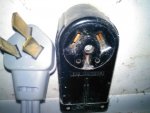- Location
- Illinois
- Occupation
- retired electrician
Telling me that the single receptacle must have a rating at least equal to that of the branch circuit is very specifically telling me that I can install a receptacle with a rating that is greater than that of the branch circuit. A very common application of this is for industrial pin and sleeve receptacles. The very often exceed the rating of the branch circuit. In many cases there is not a receptacle that can be purchased that matches the rating of the branch circuit and to use one with a rating less than the branch circuit is a violation. One brand that I use has receptacles available in the following sizes, 20, 30, 60 and 150. We have to use the 150 amp rated ones for the 70 amp welder.
The code doesn't say anything one way or the other if the receptacle rating for a single receptacle, installed an individual branch circuit, can be higher than the branch circuit rating. Because it doesn't say it the consensus of the majority that have posted on this thread say that makes it ok. Maybe the authors of the Code didn't think it was necessary to put it in black and white that it is not acceptable. Jmho, it's just common sense not to have the receptacle ampere rating higher than the branch circuit rating. It's not idiot proof. (Though in Table 210.21(B)(3) there is an exception to use a 40 or 50 amp receptacle on a 40 amp circuit. Just guessing it was tested by the manufacture and or UL, just a guess.)
Are there any sections in the code that would make it non compliant to install a higher ampere rated single receptacle than the individual branch circuit ampere rating? In other words, by installing the higher ampere rated receptacle are you inadvertently violating another section of the code?
A customer buys a new server to replace an old one. He discovers the plug on the new server will not plug into the existing individual branch circuit wall receptacle outlet. According to the majority that have posted on this thread all that needs to be done is to change out the receptacle to match that of the plug on the new server power cord. Code Compliant? Majority says, Code doesn't say he can't.
No one has said that you can do that. While there is no violation installing the larger rated single receptacle, there is a violation is connecting a load that exceeds that of the branch circuit.
1875 watt hair dryers have 15 amp plugs.What determines the plug ampere rating that a manufacturer uses for a piece of equipment? Is there an electrical safety standards that dictates the NEMA plug the manufacturer must use for his piece of equipment? Can he use a NEMA 5-15P if his equipment FLA is 14 or 15 amps? Or does NEMA electrical safety standards dictate he must use a NEMA 5-20P? Why? It has to be idiot proof. A 5-20P plug will not physically fit, plug, into a 5-15R receptacle. IF the branch circuit is 20 amps the user can simply change the 15 amp receptacle to a 20 amp receptacle.
There are no cases where the installation of the receptacle is a code violation. There may be case where using the receptacle at its rated load would be a code violation.According to the majority that have posted on this thread if the branch circuit is an individual 15 amp branch the user can install a single 5-20R receptacle. Code does not specifically say he can't. Therefore it is code compliant. Is it? Doesn't that defeat the purpose the NEMA electrical safety standards configurations for plugs and receptacles ampere ratings? Are there any sections in the Code that may be in violation when the 5-20R is installed on the 15 amp branch circuit?
Yes there is a very good chance it will never trip at 16 or even 18 or 20 amps....so are you saying a single 15 amp receptacle on a 15 amp OCPD is not safe?What if the FLA on the piece of equipment is 16 amps. Many that posted on this thread said no problem. Eventually the breaker will trip open. Guaranteed? Good chance it will never trip.
If the intended use, at the time of installation, has a load less than the rating of the branch circuit, there is no violation.Any Code violations come to mind? Here's an easy one 210.22 Permissible Loads, Individual Branch Circuits. So if a single 20 amp receptacle is installed on the individual 15 amp branch circuit is the installation Code compliant? Yeah, according to many that have posted on this thread, but did you violate another section of the code when you installed it?
Best regards,
Jim
[/QUOTE]


